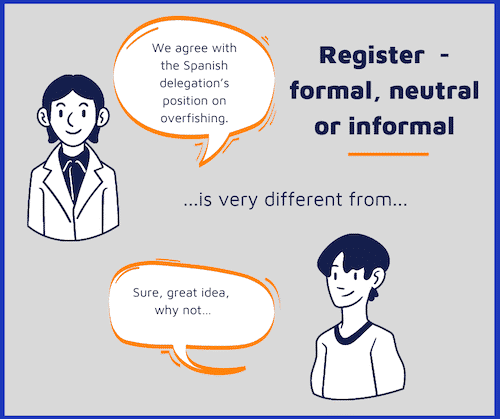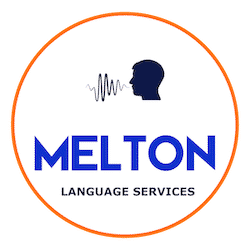«“How specific can you make the classes?”». This is the question we were asked a few years ago when we had a meeting with the HR department of a big engineering company. The objective was to plan the focus of their Business English courses for their teams who worked with international clients.
And this question was very logical, as Business English classes are usually very generalized. For this reason, in Melton Language Services, our teaching methodology is based in an extremely complete needs analysis. From there, we design specific English courses for each company, and then implement a perfect balance of input and practice. In this post, we are going to look at what our Business English courses are like.
In this post, we’ll look at how specific you can be in Business English Courses:
- What is Business English?
- Why are high-quality English Classes so difficult to find?
- How do we make classes specific to your company’s needs?
- Step 1: A good, detailed needs analysis
- Step 2: The Planning Stage
- Step 3: Implementation
- Where can I find English course tailor-made to my sector?
A little bit of history: what is Business English?
When entering the world of language teaching over 25 years ago, Business English was the new thing. Academies and teachers everywhere claimed this was going to be the solution to workers problems with English. But there was, and still is, a big problem with delivering this – the word BUSINESS.
Whose business? – The Software Developer, Scientific Researcher, HR Manager, the Civil Engineer?
As a term, it is way too generic, but unfortunately, it is still used and taught this way all over the world. If you look at any Business English course book, such as Market Leader, Business One to One, or Cambridge Business Benchmark, it has to be generic. How can it focus on the specific needs of one industry? It would exclude all the others and sell very little.
This is why you have an employee of an energy company preparing for his technical presentation to shareholders in Dubai by giving a 5-minute presentation on selling athletic shoes in China.
There are, of course, very good things about general Business English courses and books as a lot of the language structures are transversal in nature and can be used in many professional contexts.
Let’s look at the Language of Meetings as an example. Learning the structures that you need to give opinions, to agree or disagree, or to make suggestions are extremely useful tools.
Good business courses will also give you light and shade, teaching you different levels of agreement, opinions or suggestions. Just look at the differences between:
Agreement: I completely agree, AND I agree up to a point
Opinions: From my point of view, AND I am convinced that
Suggestions: I strongly suggest, AND maybe it would be a good idea to.
Other courses take it a step further and distinguish between registers, illustrating the differences between formal, semi-formal and colloquial language.

Presentation Language is another good example where structures are universally used. Anyone who has to make even a neutral register presentation would benefit from signposting tools, allowing you to move around the presentation easily, such as – to move on to or to refer back to.
All of these expressions and structures are incredibly useful and necessary but how do we take this one step further?
How can we make classes more specific and practical?
And why is it not done in the majority of cases within the language teaching world?
English for negotiations is essential for a Business English course
Also, when dealing with the Language for Negotiations, the average Business English coursebook at an Intermediate to Advanced level will give you practice with:
The First Conditional – If I deliver your product by Friday, you will give me a discount of 20%.
Or help when you don’t understand – Could you repeat that please?
However, these are still very basic and general when it comes to real-life experiences in the business world and can greatly be improved. For example,
If I deliver your product by Friday, you will give me a discount of 20%. – This is grammatically correct sentence. But when do you use it? If you say this when you are first negotiating, it would come across as very assertive and assumptive. However, it would be completely valid to use when you’re summarising and listing the points you’ve agreed on.
or
if you say, “Could you repeat that please?”, most likely the person will repeat exactly what they said before and if you didn’t catch it the first time, there’s a very good possibility you won’t understand the second time either. It would be better to say, “Could you rephrase that please? I’m not sure I’m following?”
This way you get them to ask the question or make their point using different words whilst also letting them know you aren’t certain of your understanding. Also, it dooesn’t make you sound like an English student, which is something you want to avoid in a negotiation.
Why are good Business Courses so difficult to find?
One of the biggest problems here has been a sort of acceptance by individuals, companies and institutions that there is nothing else on the market. That the most they could ask for in a course is a dynamic and didactic teacher using the generic meeting, negotiation and presentation formulas we looked at previously in abstract contexts.
The quality of the teacher is of course fundamental, and probably an overriding influence on student improvement, but imagine if you could have this great teacher giving you opportunities to replicate exactly what you do in real life.
Good teachers or courses will again take this one step further and give students linguistic advice on incorporating these more easily, using the gerund for example as a link between ideas.
Moving on to the area of finance…
Referring back to the diagram we saw earlier…
How do we make our courses even more specific?
Excellent Teachers and Detailed Tailor-made Courses: the perfect mix for achieving language goals
What can you expect from our Business English courses?
An excellent teacher and tailor-made English courses: this is the perfect combination to achieve linguistic goals. But how do we design a specific high-quality English course? We can provide the answer in only three steps.
The first step, and the most important one, is an initial needs analysis through a briefing; the second, is the planning of which methodology to follow and possible workplace situations the employee may encounter; and the third, the proper implementation of all of this in the classroom (whether that is through face-to-face classes or online classes) through the theory and practice of all the information we have gathered in the previous steps.
Step 1: How can you organize a Business English course – A good, detailed Needs Analysis
This is a prerequisite and the only way a course can be prepared properly. It needs to go further than the usual questions of:
- Do you make presentations in English?
- Do you attend meetings?
- Do you have to negotiate?
There always needs to be secondary questions. What you need is information to be able to plan the courses specifically.
Questions about preseentations:
- Who do you deliver presentations to?
- What is the subject matter?
- What is your relationship to the audience?
- How long are the presentations?
- Do you have to respond to questions at the end?
Questions about meetings:
- Are the meetings formal or a less formal working groups?
- Are the meetings interactive?
- What is the question protocol for the meetings?
- Do you sometimes have to lead the meeting?
Questions about negotiations
- Who do you negotiate with? Local suppliers? Government officials?
- Is there a time frame to the negotiations?
- Are you negotiating with figures, data, numbers
- Are you negotiating with more than one party?
- In the meeting, are you presenting your product for the first time?
- Or are you at a second meeting where you need to “seal the deal?”
- Are you persuading and convincing a client or giving information?
Once we have this information we can then move onto the next step in providing more specific courses.
Step 2. How do we plan the Business English course:
There are several factors to take into consideration when planning a course, but practicality and balance are two of the most important ones.
Case study 1 – Meetings in English with foreign clients
Take for example a project manager and his/her team for a Spanish telecommunications company. From the Needs Analysis we know that they travel to the UK on a regular basis to participate in meetings regarding the setting up of a 5G network infrastructure in collaboration with a UK provider.
The employees need to participate in meetings to establish project milestones, give presentations on technical aspects of the infrastructure and to negotiate timelines and to an extent leadership of the project.
Looking at this information the course would be divided into providing input, the language structures needed to adequately carry out these tasks, and then providing real and specific role plays and simulations to put them into practice. This latter stage is something a generic book or way of teaching is unable to provide, and something that has to be designed taking the client’s needs into account.
For example: Simulation of a First meeting with a UK provider
Group A : Spanish Team.
You have a first meeting with the project management team of ******* a UK telecommunications company.
With other members of your group brainstorm the following:
- What do you want to obtain from this first meeting?
- What do you think the other party is looking for
- What are your main, and secondary objectives?
Think about what kind of partnership you want to have, leadership roles, financial risk sharing, timelines, milestones etc.
With the rest of your group prepare a list of questions, things you want to find out in that first meeting.
You are now going to have a meeting with the UK team, remember at the end of this meeting, some sort of loose consensus needs to be reached about future work together.
Here the students will already have received input on agreement/disagreement, making suggestions, giving opinions, showing interest etc. In this case we have gone that step further and provided a realistic environment in order to practice the language skills already seen in class.
There always needs to be this balance of input, which by nature will always be more generic, and practice which should be as specific as possible. Being specific here is made possible by a thorough needs analysis and applying this analysis when planning the course.
Step 3. How does the implementation stage work?
Once the course has been designed and the materials prepared, the final step is its implementation. Here two factors are prevalent and play a key role: the teacher and the methodology. The methodology should always allow the student to practice with real life examples and should be followed by practical corrections and feedback.
Case Study 2 – English presentation in front of potential clients
The head of R&D at a Spanish Cyber Security company has to give a presentation to potential Middle Eastern clients.
From the previous needs analysis we know that the presentation has to be formal, will involve presenting data through diagrams, statistics and graphs, that there will be an element of “selling “the company to the client, and that questions will be asked at the end of the presentation.
In the planning stage of the course different areas of input have been included in the syllabus, such as, presentation language, persuasion and creating interest, the paralinguistics of a presentation and dealing with questions. Now the student has to give the presentation to the rest of the class (if it’s a group) and the teacher, and then respond to their questions at the end.
The platform has been given for the student to practice specifically what they have to do in real life but in this implementation stage the teacher’s role now becomes vital. During the presentation the teacher will take notes on mistakes, things that could be done better, and things that were done well. This will be looked at in subsequent feedback.
How to give feedback in a presentation class

Paralinguistics:
- Speed – A little fast at the start, but generally good.
- Eye contact – Good, but be careful not to focus on one side of the room.
- Body language – Generally open which is good, but be careful when highlighting parts of a diagram as your back was turned to the audience.
- Pauses – You had enough of these but remember to breathe, this will create intonation and stop you from sounding flat.
Dealing with questions
Good things:
- You remembered to respond to the questioner before answering, i.e thanks for the question, that’s an interesting question, I’m glad you asked that.
- The language of postponing a question was excellent, and it’s difficult….
I’ll get back to you after the presentation with that information, I’m afraid I don’t have all the details with me right now
Things to work on
- Don’t say “I don’t understand you “remember your clients are also non-native and they could think this is a reflection of their language level. Use the phrases we saw in class, I didn’t quite catch that, do you mean….
- Also, avoid sentences like, “As I told you earlier”, it is too direct and again puts the emphasis on their lack of attention. Remember what we saw in class: as we saw earlier, as I mentioned previously, these are far more neutral and won’t cause offence.

Where can you find a high-quality Business English course?
If you are looking for a high-quality Business English Course where you can learn professional English tailor-made to your sector and relevant to your day-to-day work, perhaps you’ve asked yourself the question «How specific can the classes be?».
As you can see, the answer is very simple. Melton Language Services courses for Business English can be as specific as you need. Thanks to our 3-step design model of (briefing, planning and implementation) we can create tailor-made training sessions for your business needs so that you can meet your objectives in whatever language.
Other articles you might find interesting:
Contact Us About Your Language Training Needs
About
At Melton Language Services, we provide professional English training to ministries and companies that need fast results with specific needs. Our dynamic methodology gives companies the tools they need to ensure their employees have the professional skills they need to be effective. Individual or group, private or public sector. We provide the service you need and deserve.


0 Comments